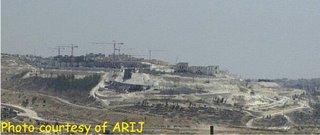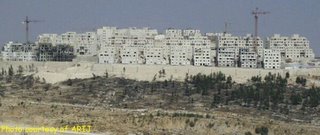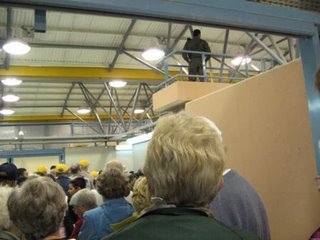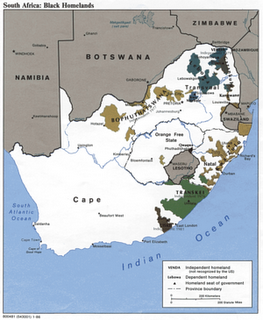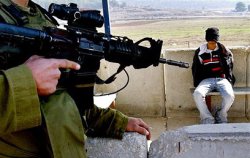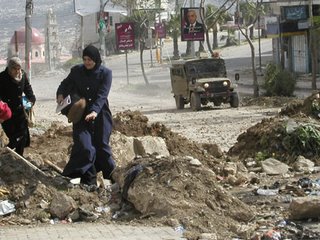By Frubious Bandersnatch"Positive Conditions" - The Water Crisis in GazaThe political rhetoric and frequent violence of the Israeli-Palestinian conflict often serve to mask underlying environmental issues which, if not resolved, may pose an even greater threat to the well-being of the Palestinian population than the guns and bombs of the military occupation. Environmental degradation threatens to undermine the viability of any future Palestinian state and create conditions that will make life in many parts of the Palestinian Territories impossible. Many environmental problems are accelerated and exacerbated by Occupation practices, which prevent effective environmental management. This problem is particularly acute in Gaza in relation to the water resources and the ongoing military conflict.
The roots of Gaza's water problem lie in the over-population of the area due to a high influx of refugees in 1948, when approximately 200 000 people fled to Gaza from the Jaffa and Beersheva areas of what is now Israel following Israel's War of Independence. The original population of the Gaza Strip at that time was 80 000 people, thus this represented an increase of some 250 %. Today, over three quarters of the estimated Gazan population of 1.4 million are registered refugees (UNRWA, 2006).
The Gaza Strip is a very small area of land with a total area of only 360 km2. It is underlain by a shallow aquifer, which is contiguous with the Israeli Coastal Aquifer to the north. Gaza is the 'downstream user' of the Coastal Aquifer system, and hence water abstraction in Gaza does not affect Israeli water supplies. The Gaza Aquifer has a natural recharge rate of approximately 65 million cubic metres (MCM) of water per year from rainfall and lateral inflow of water from Israel and Egypt (CAMP, 2000).
This aquifer is essentially the only source of fresh water in the Gaza Strip. By 1967, when Israel occupied Gaza, the sustainable yield of the aquifer was being fully utilized (Nasser, 2003). Since then, as the population has grown, so too has the demand for fresh water. No serious attempt was made at exercising any water management strategy in the Gaza Strip during the Israeli administration, with the number of registered wells increasing from 1200 in 1967 to 2100 in 1993 (Nasser, 2003). Abstraction from the aquifer was approximately 110 MCM per year by 1993, resulting in falling water levels and degrading water quality due to seawater infiltration, caused by the over-pumping that had been taking place. Likewise, there was little investment in maintaining or improving the deteriorating water infrastructures of Palestinian municipalities during this period, despite taxes being payed by Palestinians to the Israeli government (World Bank, 1993).
In 1994, the Gaza-Jericho agreement placed water resources in the Gaza Strip under the control of the newly formed Palestinian Authority and in 1995 the Palestinian Water Authority (PWA) was formed and given the mandate for managing water in the Palestinian Territories. At this time it was widely recognized that there was a serious environmental problem with the Gaza Aquifer, with experts predicting that if nothing was done, the entire aquifer would become unusable by the year 2000 (Bleier, 1994). In addition, the water infrastructure was in a very poor state, with 50 % of water being lost through leaking pipes (PWA, 2003). Therefore the PWA, with the help of international donors (principally the United States Agency for International Development - USAID), set out to develop a management strategy for the Gaza Aquifer and engaged the engineering firm Metcalf & Eddy to carry out an environmental survey and draw up a management plan. The Integrated Coastal Aquifer Management Plan (CAMP) was drawn up in 2000, with an implementation period of 20 years.
The main components of the CAMP included reducing the amount of water pumped from the aquifer for agricultural irrigation whilst simultaneously improving supply of drinking water to the population by providing additional water from sources other than the Aquifer. These included import of water from Israel, construction of seawater desalination plants and improving wastewater treatment to allow it to be used for irrigation and managed aquifer recharge. It was envisaged that, in the longer term, following a political settlement with Israel and resolution of the Palestinians' water rights in the West Bank, a pipeline could be constructed between the West Bank and Gaza to ensure adequate supplies for the growing population.
 Map of the water resources of Israel/Palestine, and water utilization along the Jordan River. From the Palestinian Academic Society for the study of International Affairs (PASSIA) 2002 (www.passia.org).
Map of the water resources of Israel/Palestine, and water utilization along the Jordan River. From the Palestinian Academic Society for the study of International Affairs (PASSIA) 2002 (www.passia.org). If implemented on schedule, it was expected that the CAMP would bring the Gaza Aquifer back into a positive water balance by 2007, whereas
"failure to implement the CAMP in accordance with the schedule will result in continuing decline in the quantity and quality of the aquifer water " (CAMP, 2000).
Unfortunately, completion of the CAMP (May, 2000) narrowly preceded the outbreak of the Al Aqsa Intifada in September 2000. Despite initial attempts to implement the plan, and small progress in some areas, little has been achieved since then. The number of agricultural wells, many of them unregistered, has increased to approximately 4000 (PCBS, 2004); the supply of water from Israel has declined by approximately half from 1998 to 2004 in breach of the Oslo Accords (WaSH MP, 2005); construction of the planned regional desalination plant halted in 2003 when one of the workers was killed; and Gaza's wastewater treatment facilities are still vastly inadequate with 80 % of sewage being discharged untreated into the environment (UNEP, 2003).
In addition, missile strikes and ground incursions have repeatedly damaged and destroyed pipelines, and maintenance personnel have been arrested, shot at or even killed whilst trying to carry out repairs (E-WaSH 2002). Inadequate sewage treatment infrastructure and damage to wastewater and drinking water pipelines has allowed sewage water to contaminate drinking water supplies, leading to sharp increases in water borne diseases in many areas. Failure to control over-pumping has led to sea-water intrusion into the aquifer to the extent that, in 2003, only 10 % of the wells produced water of World Health Organization (WHO) drinking water standards (UNEP, 2003). Most recently, this years' Israeli invasion of Gaza (Operation Summer Rain, June 2006) has caused untold damage to water infrastructure, with destruction of the Gaza Electric Station affecting the operation of the majority of wells, pumping stations and sewage treatment facilities (CMWU, 2006).
In short, Gaza teeters on the brink of a humanitarian and environmental catastrophe and urgent action is required to prevent widespread suffering. To compound matters, USAID have recently pulled out of the Palestinian water sector, abandoning ongoing projects and closing their contactors' offices, in an international aid embargo aimed at undermining the Hamas government. As has proved to be the case with so many international sanctions and embargoes (like Iraq for example), the result of this move is the communal punishment of every man, woman and child in the country targeted. It is a clumsy, inept and immoral means of pressuring the government to fall into line; and primarily hurts the most vulnerable members of the society.
The options for improving the water situation in Gaza remain effectively unchanged since 2000. Namely, additional supplies must be made available: through desalination, wastewater treatment and reuse, import from Israel, or import from the West Bank. Currently, the unstable conditions in the Gaza Strip make large scale engineering projects impossible to implement. The less technically difficult options of water import from Israel or the West Bank are loaded with political implications and complexities. Both require the cooperation of Israel to ensure their implementation as additional pipelines would need to be constructed, and in the first case, the Israeli water company, Mekorot, would have to supply the water; whereas in the second, a pipeline would have to be constructed across Israeli territory and furthermore, an agreement would have to be reached on Palestinian water rights in the West Bank.
The water situation in the West Bank is almost the exact inverse of Gaza, in that there are relatively abundant water resources in the Mountain Aquifer system and Jordan River, but there is very little access to or sovereignty over them. This is due to the fact that Palestinians have been denied any access to the Jordan River waters since 1967, and 80 % of the Mountain Aquifer water is utilized by Israel, which is downstream of the West Bank in terms of water usage. Thus control over water resources was very tight during the Israeli administration (1967 – 1995), with only 23 licenses being granted for new wells, and the number of working wells in fact decreasing from 413 in 1967 to 300 by 1983 (Nasser, 2003). Many communities in the West Bank currently suffer from severe water shortages, and 13 % of the West Bank population are not connected to any form of water network (WaSH MP, 2005). The Oslo Agreements of the 1990s deferred definition of Palestinian water rights in the West Bank to final status negotiations, which have not yet taken place.
Thus resolution of Palestine's water problems is utterly dependent on cooperation from Israel; and inaction will lead to a serious environmental disaster in Gaza and to continued suffering for many water starved communities in the West Bank. Water shortage also undermines the agricultural sector and prevents it from developing, with consequences for the food security and economic well-being of the Palestinian population. In short, access to adequate water supplies underpins the viability of life in the Palestinian Territories.
When considering the likelihood of cooperation being forthcoming from Israel, it is worth reviewing several statements that have been made by Israel's leaders in recent years. Yitzak Rabin, the architect of the Oslo Peace Process stated in 1974, during his tenure as Israeli Minister of Defense stated that:
"Israel will create in the course of the next 10 or 20 years conditions which would attract natural and voluntary migration of the refugees from the Gaza Strip and the West Bank to Jordan." (Yitzak Rabin, former Labor Party Prime Minister) It may be that he had changed his mind by the time he made the historic move of shaking hands with Yasser Arafat and legitimizing the Palestinian Authority. It is possible, although various features of the Oslo Accords, such as the minimal transfer of sovereignty over environmental resources would suggest otherwise. It is possible. No-one can tell what Israel and Palestine would have looked like today if Rabin had not been assassinated by a far right Jewish extremist. However, if Rabin no longer believed in transfer of the West Bank and Gazan populations, Ariel Sharon, architect of the Gaza Disengagement Plan certainly did:
"It is the duty of Israeli leaders to explain to public opinion, clearly and courageously, a certain number of facts that are forgotten with time. The first of these is that there is no Zionism, colonization or Jewish state without the eviction of the Arabs and the expropriation of their lands." (Ariel Sharon, former Likud Party Prime Minister, Agence France Press, November 15, 1998).
"
You don’t simply bundle people onto trucks and drive them away. I prefer to advocate a positive policy, to create, in effect, a condition that in a positive way will induce people to leave." (Ariel Sharon, August 24, 1988)
Olmert, Sharon's heir, has also recently avowed his commitment to the ideal of 'Eretz Israel':
"Only a person in whose soul Eretz Yisrael burns knows the pain of letting go of our ancestral heritage" (Ehud Olmert, May 4th 2006, speech to the Knesset whilst presenting the Unilateral Disengagement Plan) "I believed, and to this day still believe, in our people’s eternal and historic right to this entire land." (Ehud Olmert, Israeli Prime Minister, to the US House of Representatives, June 2006) What can be perceived here is that many of Israel's leaders, whilst appearing to make concessions to the Palestinians, have in fact retained an ideological commitment to 'Eretz Israel from the river to the sea', and have concentrated their policy towards creating 'facts on the ground' that will make life for the Palestinians impossible, hence creating the 'positive conditions' required to induce people to leave. A close examination of the Gazan water crisis illustrates this point very well. If nothing is done, there will be no usable water resources in Gaza and it will become impossible to live there. Nothing can be done without Israeli cooperation. Thus whilst Israel may not have intentionally set out to create the Gaza water crisis, it fits in rather well with Zionist expansionist aspirations to perpetuate the situation and prevent meaningful action being taken to resolve it.
If one examines the process that is taking place in the West Bank, whereby a series of Bantustans are being created through land confiscation, settlement expansion and the building of the 'Separation Barrier', with the population becoming ever more urbanized and access to resources such as water and land becoming ever more restricted, it is possible to see that what in effect is happening is the creation of a number of 'mini Gazas'. To illustrate this point: the building of the Wall in the north of the West Bank led to the destruction of 25 wells and the isolation of 50 more (WaSH MP 2004), isolating many localities from their only source of water and destroying the irrigated farming industry. One estimate anticipates that when completed, the Wall will isolate Palestinians from 65 % of their water resources (CAABU, 2003), although so much uncertainty surrounds its final route that no solid predictions can be made. Thus a number of highly urbanized communities will be created, with poor economic and social conditions and inadequate resources to sustain themselves. This is the manifestation of Sharon's "positive policy", which essentially amounts to ethnic cleansing by other means, causing widespread suffering, illness and death.
 Palestinian water resources, the Separation Barrier and the Eastern Segregation Zone (ARIJ GIS, 2005)
Palestinian water resources, the Separation Barrier and the Eastern Segregation Zone (ARIJ GIS, 2005) It is clear that the viability of the Palestinian state and the livelihoods of the Palestinian people are being systematically undermined. The situation is not yet so far gone that it is irreversible. However, given the advantages to Israel of allowing the current state of affairs to persist, and the urgency of immediate action to avert catastrophe in Gaza, it is clear that international intervention is required to protect the human rights of the Palestinian people and prevent humanitarian and environmental disaster. The current violent conflict in the region should not blind us to the pressing need to address underlying environmental issues, which have the potential to cause as much, indeed possibly much greater suffering, than direct military actions.
References:UNRWA (2006) The Gaza Refugees - http://www.un.org/unrwa/refugees/gaza.html United Nations Relief and Works Agency for Palestinian Refugees.
CAMP (2000) Integrated Aquifer Management Plan, Coastal Aquifer Management Program. Metcalf & Eddy in cooperation with the Palestinian Water Authority (PWA). United States Agency for International Development, May 2000.
Nasser Y (2003) Palestinian Water Needs and Rights in the Context of Past and Future Development. In Water in Palestine: Problems – Politics – Prospects. Palestinian Academic Society for the Study of International Affairs (PASSIA), Jerusalem.
PCBS (2004) – Palestinian Central Bureau of Statistics http://www.pcbs.gov.ps
World Bank (1993) Developing the Occupied Territories – An Investment in Peace. Washington, USA, 1993.
Bleier R (1994) Israel's Appropriation of Arab Waters: an Obstacle to Peace. Middle East Labor Bulletin, 1994.
PWA (2003) Quantities of Water Supply in the West Bank Governorates. Directorate General of Resources and Planning, Palestinian Water Authority.
E-WaSH (2002) 'Nablus Water Situation', 'Ramallah Water Situation', Tulkarm Water Situation'; Internal Reports; 14th April 2002. Emergency Water, Sanitation and Health Committee.
WaSH MP (2004) Water for Life: Israeli Assault on Palestinian Water, Sanitation and Hygiene during the Intifada. Water, Sanitation and Hygiene Monitoring Project (WaSH MP), Palestinian Hydrology Group (PHG).
WaSH MP (2005) Water for Life: Continued Israeli Assault on Palestinian Water, Sanitation and Hygiene during the Intifada. Water, Sanitation and Hygiene Monitoring Project (WaSH MP), Palestinian Hydrology Group (PHG).
UNEP (2003) Desk Study on the Environment in the Occupied Palestinian Territories. United Nations Environment Programme, 2003.
CAABU (2003) Fact Sheet: 'Israel's Security Wall: It's Impact on Palestinian Communities.' Council for the Advancement of Arab-British Understanding, October, 2003.
CMWU (2006) Latest Situation Report about Water and Wastewater Due to Prevailing Security Conditions. Coastal Municipalities Water Utility, July 4th 2006, Gaza, Palestine.

 An example of shameful and unnecessary environmental destruction.
An example of shameful and unnecessary environmental destruction.

 Har Homa scars and dominates the Bethlehem landscape. From virtually every corner of the city, Har Homa looms.
Har Homa scars and dominates the Bethlehem landscape. From virtually every corner of the city, Har Homa looms.